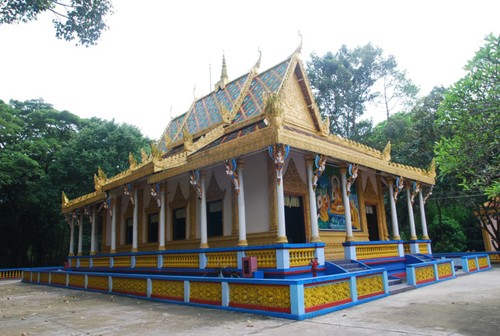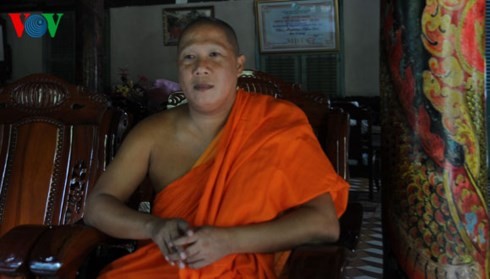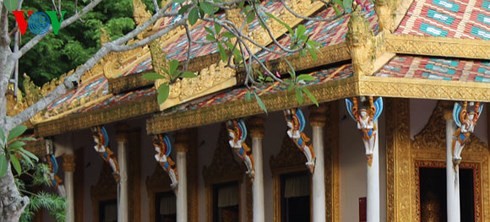 Dơi pagoda is over 400 years old (Photo: Lan Anh/VOV5) Dơi pagoda is over 400 years old (Photo: Lan Anh/VOV5) |
Dơi pagoda’s architecture exhibits both Vietnamese and Cambodian features. It was initially named “Serây tê chô mahatúp”, which means a blessing of good virtue. It was called Mã Tộc by the local Chinese minorities. The pagoda is commonly known as “Dơi” because it is home of a big colony of bats. According to the bibliography, this is one of the most intact examples of pagodas in the Mekong Delta.
Venerable Lâm Tú Linh, Dơi pagoda’s deputy abbot, said: “Dơi pagoda was built in 1569 and has been restored several times since then. A huge restoration took place in 1960 at the main hall, which was almost destroyed by a blaze in 2008 and fully restored again a year later. The pagoda was recognized as a national cultural and historical relic site in 1999”.
 Venerable Lâm Tú Linh, deputy abbot of Dơi pagoda. Venerable Lâm Tú Linh, deputy abbot of Dơi pagoda. |
The signature Khmer architecture is preserved in the Dơi pagoda. The walls of the main hall is comprised of bricks. The four corners of its tile roof are curved and engraved with Naga cobras. A tower rises in the middle. Pillars along the corridor surrounding the main hall are adorned with Kemnar maidens with palms pressed together chest-high in a prayerful gesture to all visitors. Inside the hall is a stone statue of the Buddha sitting high on a 2-meter lotus throne and another statue of the Buddha riding on the snake genie Muchalinda. The curved walls feature pictures depicting the lifecycle of the Buddha from birth to enlightenment and entering into nirvana. The pagoda preserves sutras written on palmyra leaves and rare and precious treasures of the Khmer belief system. The pagoda courtyard is shaded by ancient trees. There are several stupas and a stilt house where monks rest and study. The eye-catching brown and black bats which live in the pagoda weigh about 1.5 kilograms each with an average wingspan of 1.5 meters. They hang up-side-down from the trees during daytime and look like clusters of ripe fruit. Locals say there are as many as tens of thousands bats.
 Pillars along the corridor surrounding the main hall are adorned with Kemnar maidens Pillars along the corridor surrounding the main hall are adorned with Kemnar maidens |
Hồng Thị Thu Châu lives nearby Dơi pagoda:“It’s still mysterious why the bats live here. Some people think the reasons may include the nearby fruitful gardens, the high ancient trees, and the peaceful atmosphere of Dơi Pagoda”.
Oddly, the bats live in the fruit trees but never the eat fruit growing in the pagoda grounds. When it begins to get dark, they leave the pagoda to find food elsewhere and return early the next morning. It is also unknown why there are many other tranquil pagodas in Sóc Trăng province but the bats only inhabit in this particular one. Another mystery is that the bats don’t fly straight but avoid the roof of the main hall. Local people consider them auspices that always protect them.
Dơi pagoda is an attractive tourist destination in the Mekong Delta. This is a dedicated space for religious practice which aims to encourage people to do good deeds.